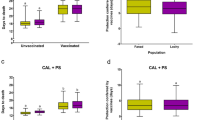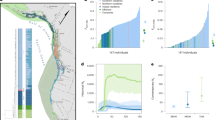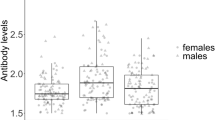Inbreeding influences the response of these animals to different pathogens in the wild.
Abstract
Inbreeding in animals can increase their susceptibility to pathogens, but direct evidence from wild populations is scarce1,2 and it is unclear whether all pathogens are affected equally. Here we analyse rescued California sea lions afflicted with a range of different pathogens, and find that sick animals have higher-than-normal parental relatedness, with the extent varying among disease classes. Our findings indicate that mortality in natural populations may not be entirely random and that inbred individuals could act as more effective reservoirs of infectious agents.
Similar content being viewed by others
Main
We sampled tissues from 371 stranded California sea lions (Zalophus californianus; Fig. 1) that were being rehabilitated at the Marine Mammal Center in Sausalito, California. Each individual was assessed for age category (based on length, pelage, sagittal-crest size and tooth development) and health status. We identified six classes of health problem3,4,5,6: trauma (inflicted by boats, gunshot or net trapping), carcinoma, bacterial infection, helminth infection, intoxication by domoic acid as a result of ingesting prey contaminated by the toxin-producing alga Pseudonitzchia australis3, and 'nonspecific' (used to classify morbid sea lions with subclinical infections6). Animals suffering from trauma were considered as controls that were representative of the normal adult population.
All sea lions were scored for 11 highly polymorphic microsatellite DNA markers7,8,9,10 that were in Hardy–Weinberg equilibrium. Homozygous individuals were genotyped twice to guard against the possibility of allele drop-out. As a measure of inbreeding, we estimated the relatedness of an individual's parents by calculating an 'internal relatedness' factor11.
Mean internal-relatedness values varied significantly among the six different disease classes (analysis of variance (ANOVA): F5,370 = 8.97, P = 10−8), being lowest for trauma and highest for carcinoma (Fig. 2). A generalized linear model did not reveal any significant effect of sex or age class on internal relatedness and disease.
Carcinoma, n = 13; helminth infection, n = 72; nonspecific, n = 51; bacterial infection, n = 98; algal toxin, n = 101; trauma (control), n = 36. Values are means ± s.e. The mean internal relatedness value of trauma animals (−0.004) is indistinguishable from zero, as would be expected for individuals born to randomly mated parents5.
After trauma, the next-lowest internal-relatedness values are found for individuals affected by algal toxin. The difference in mean internal relatedness between trauma and toxin is significant (two-tailed t-test: t = 2.74, d.f. = 135, P = 0.007). Removal of these two non-infectious disease classes does not eliminate interclass differences (ANOVA: F3,233 = 5.66, P = 0.0009).
For stringent comparison between infectious agents, we also removed carcinoma (although not an infectious disease, it is strongly associated with herpesvirus infection in sea lions4) and the nonspecific category because the sources of morbidity were not defined. This leaves bacterial infection (mean internal relatedness, 0.11) and helminth infection (mean internal relatedness, 0.20), for which the difference is significant between both groups (two-tailed t-test: t = 3.07, d.f. = 168, P = 0.002). Thus, the extent to which inbreeding increases susceptibility to infectious disease varies depending on the class of pathogen involved.
The trend that is evident in Fig. 2 indicates that an individual's susceptibility to a biochemically simple challenge, such as a toxin, may not be markedly affected by inbreeding; however, inbreeding seems to become an important factor in susceptibility to more complex, long-lived gut parasites that interact with many aspects of the host's biology. To test this possibility, we surveyed faecal eggs to determine the number of different types of helminth infection in affected sea lions, and found a significant positive regression of parasite diversity on inbreeding (r2 = 0.11, n = 72, P = 0.003). This indicates that the more inbred animals harbour a wider range of helminth infections.
To investigate whether a sick individual's parental relatedness also affects its response to treatment, we recorded the recovery times of animals with 'nonspecific' morbidity that were not receiving any treatment against a specific disease. We found a significant positive regression of rehabilitation time on inbreeding (r2 = 0.14, n = 43, P = 0.01), indicating that the more inbred individuals take longer to recover.
All of the challenges (apart from trauma) that we studied were influenced by inbreeding, which supports findings that link heterozygosity of the major histocompatibility complex with an effective response to challenge (see ref. 12, for example).
The importance of genetics in demography and conservation is contentious13. Our results indicate that the role of stochasticity in the natural mortality of vertebrates may be less important than was previously thought, and that inbreeding could have a significant impact on conservation programmes and the dynamics of wildlife diseases. The most inbred individuals not only cost more to treat and rehabilitate, but they could also act disproportionately as reservoirs of infectious agents when they are subsequently released.
References
Keller, F. & Waller, D. M. Trends Ecol. Evol. 17, 230–241 (2002).
Coltman, D. W., Pilkington, J. G., Smith, J. A. & Pemberton, J. Evolution 53, 1259–1267 (1999).
Gulland, F. M. D. et al. Vet. Rec. 150, 475–480 (2002).
Lipscomb, T. P. et al. Vet. Pathol. 37, 609–617 (2000).
Goldstein, T. et al. Aquat. Mamm. 25, 43–51 (1999).
Gage, L. J., Gerber, J. A., Smith, D. M. & Morgon, L. E. J. Zoo Wild. Med. 24, 41–47 (1993).
Coltman, D. W., Bowen, W. D. & Wright, J. M. Mol. Ecol. 5, 161–163 (1996).
Allen, P., Amos, W., Pomeroy, P. P. & Twiss, S. D. Mol. Ecol. 4, 653–662 (1996).
Hoelzel, A. R., Campagna, C. & Arnborm, T. Proc. R. Soc. Lond. B 268, 325–332 (2000).
Buchanan, F. C., Maiers, L. D., Thoe, T. D., DeMarch, B. G. & Stewart, R. C. Mol. Ecol. 7, 1083–1085 (1998).
Amos, W. et al. Proc. R. Soc. Lond. B 268, 2021–2027 (2001).
Penn, D. J., Damjanovich, K. & Potts, W. K. Proc. Natl Acad. Sci. USA 99, 11260–11264 (2002).
Frankham, R., Ballou, J. D. & Briscoe, D. A. Introduction to Conservation Genetics (Cambridge Univ. Press, Cambridge, UK, 2002).
Author information
Authors and Affiliations
Corresponding author
Ethics declarations
Competing interests
The authors declare no competing financial interests.
Rights and permissions
About this article
Cite this article
Acevedo-Whitehouse, K., Gulland, F., Greig, D. et al. Disease susceptibility in California sea lions. Nature 422, 35 (2003). https://doi.org/10.1038/422035a
Issue Date:
DOI: https://doi.org/10.1038/422035a
This article is cited by
-
Mixtures of genotypes increase disease resistance in a coral nursery
Scientific Reports (2022)
-
Identification of candidate genes associated with bacterial and viral infections in wild boars hunted in Tuscany (Italy)
Scientific Reports (2022)
-
Intronic primers reveal unexpectedly high major histocompatibility complex diversity in Antarctic fur seals
Scientific Reports (2022)
-
Climate Change Impacts on Himalayan Biodiversity: Evidence-Based Perception and Current Approaches to Evaluate Threats Under Climate Change
Journal of the Indian Institute of Science (2021)
-
A genome-wide association study explores the genetic determinism of host resistance to Salmonella pullorum infection in chickens
Genetics Selection Evolution (2019)
Comments
By submitting a comment you agree to abide by our Terms and Community Guidelines. If you find something abusive or that does not comply with our terms or guidelines please flag it as inappropriate.





